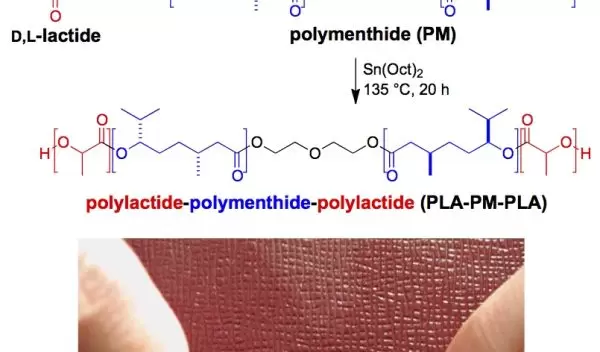
Center Creates Polymers Made From Safe and Renewable Natural Resources
Sometime soon, you could be drinking your fruit smoothie from a plastic cup that started life as a pile of grass clippings. Moreover, these same kinds of cups also might end up as compost on your lawn.
Scientists are working to reduce the nation's reliance on fossil fuels by developing environmentally friendly and cost effective plastics from natural, sustainable and renewable materials, such as vegetable oils, starches, sugars, and terpenes--essential organic oils produced by plants, flowers and conifers--even one day recycled grass clippings.
Researchers especially are focused on creating polymers that manufacturers can produce efficiently from renewable starting materials, are nontoxic and can be composted.
The goal is to "reduce reliance on petroleum-based plastics, and help mitigate environmental damage by designing materials that are compostable and, while in use, are harmless," says Marc Hillmyer, a professor of chemistry at the University of Minnesota and director of its Center for Sustainable Polymers (CSP).
"Many products today contain additives or residual substances that have raised health concerns," he adds. "We'd like to see plastics made from renewable resources that won't ultimately go into landfills, or end up in our rivers, lakes and oceans. Why not grass clippings? We put them in compost, why not put them in a bio-refinery, make an advanced plastic out of it, then throw that back in the compost? Combing biotechnology advances with state of the art materials chemistry holds tremendous promise for the future of plastics."
CSP has formed partnerships with more than 25 company affiliates in conducting research and developing new technology to create polymers made from safe and renewable natural sources, thus decreasing the industry's dependence on fossil fuels. Also, it hopes to encourage students, underrepresented minorities in particular, through new education efforts and outreach to consider careers in science, math and engineering in fields related to sustainable resources.
"Nature provides us with a wealth of opportunities to take complicated molecular structures and design materials with new properties that cannot be achieved using the traditional petroleum based products," Hillmyer says. "There is tremendous untapped potential to take natural products and turn them into materials that have sustainable benefits. Replacing the current polymers is one goal, but the future is really in designing, discovering and developing new bio-based materials with more functionality than what we have now."
The center started in 2009 within the university's college of science and engineering, with seed money from the school's Initiative for Renewable Energy and the Environment (IREE) large grant program. The grants support early-stage, high-potential projects in emerging fields of renewable energy and the environment.
In September 2011, the National Science Foundation announced it would provide the center with $1.5 million in funding over the next three years from its Centers for Chemical Innovation program.
The center also is working with the University of Minnesota Office for Diversity Outreach, the North Star STEM Alliance and the University of Minnesota Urban Research and Outreach/Engagement Center to find ways to broaden minority students' participation in its programs.
Center scientists have recruited at least two dozen companies that want to become involved, among them, 3M Co., Cargill, Dow Chemical Co. and H.B. Fuller. "We are trying to do both science and technology, but we need help, and so does industry," Hillmyer says. "We want to partner with companies who have an interest in profiting from sustainable, renewable materials.
"I think companies recognize that the volatility of the petrochemical market brings business challenges, and there is added benefit to have a green component to their products," he adds. "Sure, companies want to make money, but there also are people in these companies who are passionate about change for the good of society."
The researchers' principle goal "is to put basic research first," Hillmyer says. "We need to understand how to put the molecules together and how they behave in real materials."
There already are some biodegradable polymers in consumer products, for example, polylactide, or PLA, which is derived from corn and used in clothing, cups, packaging items and disposable tableware. On a global scale, PLA represents less than 1 percent of the total plastics market, according to Hillmyer, in part because "it doesn't quite meet some of the property requirements that petroleum plastics do," he says. "It can't be used in everything, for example, in durable goods that have to resist impact, such as a car bumper."
Among other things, center scientists are researching ways to make PLA stronger, for example, "by cleverly adding small amounts of an additive, we can improve its mechanical strength by more than a factor of 10," Hillmyer says. This result was recently published in Macromolecules, the nation's premier journal on polymers.
In other projects, the researchers are working on new materials for pressure sensitive adhesives, such as those found on popular sticky notes. These are petroleum based, and are problematic to recycle because "they literally gum up the system," Hillmyer says.
The researchers have developed a new hybrid biodegradable material made from PLA and a second polymer, derived from menthol, with "pretty remarkable adhesive properties," Hillmyer says. Among other things, "we are studying it to see if it makes paper recycling more environmentally friendly," he says.
Also, the scientists are working on catalytic technology that can convert renewable feed stocks into the starting material for "the non-renewable polymers we know and love," Hillmyer says. "But, instead of getting them from oil, we're getting them from feed stocks like carbohydrates, cellulose and wood.
"The future of sustainable polymers is bright," Hillmyer adds. "There is a need to develop advanced materials that not only meet stringent technical requirements, but also do so in a way that is environmentally sound. With basic research, partnerships with industry and a knowledgeable workforce, I believe we can achieve this laudable goal."
